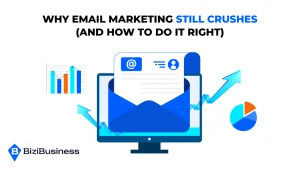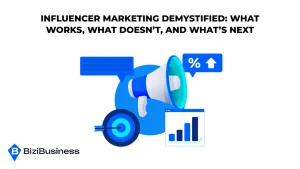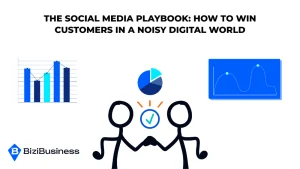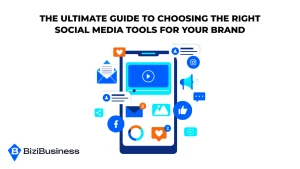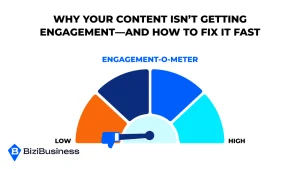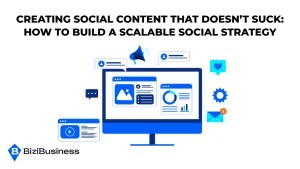BiziTopics
Reel Them Back In: Reengage Your Audience with Remarketing Ads
BiziBusiness
Jul 8, 2025
22 min read
Bringing visitors to your website is just the first step.
The real challenge? Turning those visitors into customers.
The reality is that most people don’t convert on their first visit. They might browse a few pages, add items to their cart, and then leave without completing the purchase.
That’s where remarketing ads come in.
Instead of letting potential customers slip away, remarketing allows you to reconnect with people who have already shown interest in your brand.
It’s not about being pushy—it’s about giving them a gentle nudge and reminding them why they visited in the first place.
Remarketing ads are powerful because they target users who are already familiar with your products.
Done right, they can significantly increase your conversion rates and maximize the value of your existing traffic.
What Are Remarketing Ads (and Why Do They Work)?

Reconnect with potential customers who almost converted.
Remarketing ads are a powerful digital marketing strategy designed to re-engage users who have previously interacted with your brand.
Instead of trying to attract new visitors, remarketing focuses on bringing back people who have already shown interest but didn’t complete a desired action—like making a purchase or signing up.
How Remarketing Ads Are Different from Regular Ads
Unlike traditional display ads that target a broad audience, remarketing ads are highly targeted. They are triggered when users:
- Visit specific pages on your website
- Abandon their shopping cart
- Interact with your brand on social media
- Search for related keywords
- Engage with your previous ads or content
The Key Difference:
- Regular Ads: Target new audiences who may not know your brand.
- Remarketing Ads: Target people who already know your brand but haven’t converted yet.
By focusing on warm leads rather than cold outreach, remarketing ads are typically more effective at driving conversions.
Why Remarketing Ads Are Essential
- Higher Conversion Rates: People are more likely to buy when they’re already familiar with your brand.
- Personalized Experience: Ads can be tailored based on previous interactions, making them more relevant.
- Cost-Effective: Since you’re targeting an audience that has already shown interest, your ROI tends to be higher.
- Increased Brand Recall: Repeated exposure helps keep your brand top-of-mind.
- Nudges Toward Action: Sometimes, users just need a reminder to complete their purchase.
Key Stats to Consider:
- Remarketing ads can increase conversion rates by up to 161% compared to standard display ads.
- Users who see remarketing ads are 70% more likely to convert.
- Cart abandonment emails (a form of remarketing) have an average open rate of 45% and a click-through rate of 21%.
The Psychological Advantage:
People are naturally drawn to familiarity.
If a user has already shown interest in your product, seeing it again can reignite their desire to own it.
This is especially true if the ad feels personalized—reminding them of what they liked without feeling intrusive.
Understanding User Intent: Why They Didn’t Convert the First Time
Remarketing isn’t just about showing the same ad—it’s about addressing why they left.
Not every visitor will convert on their first interaction with your brand—and that’s completely normal.
People browse, compare, and take time to make decisions. The key to successful remarketing is understanding why they didn’t convert in the first place.
Let’s explore the common reasons users don’t convert and how remarketing can specifically address each issue.
1. Cart Abandonment: They Didn’t Complete the Purchase
One of the most common challenges in e-commerce is cart abandonment.
A user shows clear intent by adding items to their cart, but something stops them from completing the purchase.
Why It Happens:
- Unexpected shipping costs or fees
- Complicated checkout process
- Concerns about payment security
- Distractions or second thoughts
- Simply not ready to buy yet
Remarketing Strategy:
- Show the Abandoned Product: Use dynamic ads that display the exact items left in the cart.
- Offer an Incentive: Include a small discount or free shipping to encourage completion.
- Create Urgency: Mention limited stock or time-sensitive deals.
- Address Concerns: Highlight secure checkout or hassle-free returns.
2. Product Comparison: They’re Weighing Their Options
Sometimes, users leave your site because they’re comparing your product with competitors.
They might visit multiple sites before making a decision.
Why It Happens:
- Looking for better pricing
- Comparing features or reviews
- Checking for discounts or bundled offers
Remarketing Strategy:
- Highlight Unique Selling Points: Showcase what makes your product stand out (e.g., quality, guarantee, or features).
- Customer Testimonials: Use social proof to build confidence.
- Competitive Pricing: If you’re offering a deal, make it clear.
3. Lack of Immediate Need: They’re Just Browsing
Not every visitor is ready to buy immediately. Some people visit your site out of curiosity or as part of their research phase.
Why It Happens:
- Gathering information for future use
- Bookmarking for later
- Not financially ready to purchase
Remarketing Strategy:
- Educational Content: Offer helpful guides or product comparisons.
- Stay Top-of-Mind: Use gentle reminders like, “We’re still here when you’re ready.”
- Exclusive Offers: Entice them to take the next step with a special discount.
4. Confusion or Uncertainty: They Didn’t Find Enough Information
Sometimes users don’t convert because they didn’t get the information they needed to feel confident.
If your product descriptions are vague or your website is hard to navigate, visitors may leave without buying.
Why It Happens:
- Lack of clear product information
- Unanswered questions about quality or functionality
- Uncertainty about return policies or support
Remarketing Strategy:
- Provide Clarity: Use ads that address common questions or showcase features.
- Link to FAQs: Direct users to detailed product pages or customer support.
- Offer Assistance: Include a CTA like, “Need help deciding? Chat with us!”
5. Price Sensitivity: It Felt Too Expensive
Sometimes the sticker shock can turn users away, especially if they didn’t expect added costs like shipping or taxes.
Why It Happens:
- Unexpected fees at checkout
- Perceived lack of value for the price
- Found a better deal elsewhere
Remarketing Strategy:
- Discounts or Free Shipping: Offer a small incentive to reduce the perceived cost.
- Emphasize Value: Highlight the quality or long-term benefits of your product.
- Flexible Payment Options: Mention installment plans or financing if available.
6. Distraction or Lost Interest: Life Got in the Way
Sometimes it’s not your product or site—it’s just life.
Users may have intended to complete the purchase but got distracted and forgot.
Why It Happens:
- Received a phone call or message
- Got busy with something else
- Simply forgot to finish the process
Remarketing Strategy:
- Gentle Reminder: Use light, friendly messaging to say, “Still interested?”
- Time-Sensitive Offers: Create a sense of urgency to prompt them to return.
- Multi-Platform Approach: Retarget them on social media as well as on other websites.
Understanding why users didn’t convert the first time helps you create more targeted, effective remarketing ads.
Types of Remarketing Ads You Should Know

Choose the right approach to reconnect with your audience.
Remarketing isn’t one-size-fits-all. Depending on where your audience interacted with your brand and how far they got in the buyer’s journey, you’ll need different strategies to bring them back.
Why is it important to choose the right type?
Because targeting the right way ensures that your ads feel relevant and timely, rather than repetitive or intrusive.
Here are the most effective types of remarketing ads and how to use them.
Site Remarketing: Reconnecting with Website Visitors
Site remarketing targets users who visited your website but didn’t take a specific action—like completing a purchase or filling out a form.
This is the most common form of remarketing and can be highly effective if tailored correctly.
Example:
A user browses a product page but leaves without buying. The next day, they see an ad featuring the same product with a 10% discount.
Search Remarketing: Targeting Users Based on Search Behavior
Search remarketing (also known as RLSA – Remarketing Lists for Search Ads) targets users who previously visited your site when they perform related searches on Google.
It’s a great way to capture the attention of users who are still in the research phase.
Example:
A user visits your page for running shoes but doesn’t buy. Later, when they search for “best running shoes” on Google, they see your ad again—reminding them of your brand.
Social Media Remarketing: Engaging Users on Social Platforms
Social media remarketing targets users who visited your website or interacted with your brand on platforms like Facebook, Instagram, or LinkedIn.
These ads are great for maintaining brand visibility in a familiar and casual environment.
Example:
After browsing your online store, users see a Facebook ad reminding them of the items they left in their cart, with a free shipping offer.
Email Remarketing: Follow Up with Direct Communication
Email remarketing involves sending personalized messages to users who abandoned their carts, viewed specific products, or signed up but didn’t complete their profile.
It’s an effective way to directly address concerns or offer incentives to come back.
Example:
“Did something catch your eye? Your items are still waiting in your cart—complete your order and enjoy 10% off!”
Dynamic Remarketing: Personalizing Every Ad
Dynamic remarketing takes personalization to the next level by showing users specific products or services they viewed on your website.
It’s especially useful for e-commerce, where product variety can be overwhelming.
Example:
If a user viewed a blue jacket, they see a dynamic ad featuring that exact item, plus similar jackets they might like.
Video Remarketing: Reengage with Engaging Content
Video remarketing targets users who watched your videos on platforms like YouTube.
It’s ideal for delivering engaging, visual reminders that capture attention.
Example:
Someone watches your product demo but doesn’t visit your site. Later, they see a follow-up video ad highlighting customer testimonials and a limited-time offer.
By using the right remarketing strategy at the right time, you can effectively reel your audience back in without overwhelming them.
Crafting Remarketing Ads That Capture Attention
Stand out without being annoying.
The challenge with remarketing ads is finding the balance between being persistent and being intrusive.
Since your audience has already interacted with your brand, your ads shouldn’t feel like the same old message repeated over and over.
The key to success is crafting personalized, engaging, and well-timed ads that feel relevant, not redundant.
Personalization: Make It Relevant
Generic ads are a missed opportunity in remarketing.
You already know something about your audience’s interests—so use that data to personalize your message.
Personalized ads feel less generic and more like a helpful reminder, making users more likely to engage.
How to Personalize Your Remarketing Ads:
- Dynamic Content: Automatically update ads with products or services the user viewed.
- User Names: If appropriate, add their name to create a more personal touch.
- Location-Based Offers: Mention local availability if it’s relevant.
- Tailored Messaging: Use phrases like “Still interested in…” or “Your favorite items are waiting.”
Visual Appeal: Catch the Eye Without Overwhelming
Your ad should visually stand out while still feeling consistent with your brand.
Avoid flashy, overly bright designs that feel aggressive. Instead, focus on clean, attractive visuals that hint at familiarity.
People recognize brands through visual consistency. If your ad looks professional and familiar, they’re more likely to pay attention.
How to Design Visually Appealing Remarketing Ads:
- High-Quality Images: Use crisp, professional photos—especially for product-based ads.
- Consistent Branding: Keep your logo, colors, and fonts consistent to reinforce brand identity.
- Eye-Catching Elements: Use contrasting colors to highlight discounts or CTAs.
- Minimal Text: Keep it simple—users should grasp the message at a glance.
Message Clarity: Get Straight to the Point
Don’t overcomplicate your copy.
Since remarketing ads target users who already know your brand, keep the message clear, concise, and action-oriented.
Clarity reduces friction. Users immediately know what the ad is about and what they need to do.
Tips for Writing Clear Copy:
- Focus on the Product: Mention the item they viewed or left in their cart.
- Include a Value Proposition: Why should they come back? Mention discounts, benefits, or limited-time offers.
- Direct CTA: Use simple phrases like “Complete Your Order,” “See More,” or “Shop Now.”
Emotional Appeal: Tap Into Desire or FOMO
Sometimes the reason users didn’t convert is because they weren’t sure.
Your remarketing ad can create a sense of urgency or excitement to help them make a decision.
Emotions drive action. When users feel a sense of urgency or desire, they’re more likely to return and complete the purchase.
How to Add Emotional Appeal:
- Use Urgency: Phrases like “Last chance!” or “Only a few left!”
- Highlight Social Proof: “Join 1,000+ happy customers!”
- Appeal to Desire: “Don’t miss out on your perfect pair.”
- Tap into FOMO (Fear of Missing Out): “Your favorite items are almost gone!”
Effective CTAs: Encourage Immediate Action
The CTA is the final nudge.
Make it clear, inviting, and low-pressure so users feel encouraged rather than pushed.
CTAs that are clear and actionable make it easy for users to decide on the spot.
Best Practices for CTAs:
- Action-Oriented: Use verbs like “Get,” “Shop,” “Claim,” or “Explore.”
- Create Urgency: “Shop Now,” “Don’t Miss Out,” or “Claim Your Offer.”
- Keep It Simple: Avoid long or complicated phrases.
- Match the Intent: If the user abandoned a cart, try “Complete Your Purchase.” If they just browsed, try “See What’s New.”
Frequency Capping: Don’t Overwhelm Your Audience
One of the biggest mistakes with remarketing is bombarding users with ads.
When your ads become too frequent, users experience ad fatigue and may start ignoring—or even blocking—your content.
Limiting ad frequency prevents overexposure, keeping your brand presence positive rather than irritating.
How to Set the Right Frequency:
- Limit Impressions: Cap the number of times a user sees your ad per day or week.
- Rotate Creative: Show different variations of your ad to keep it fresh.
- Set Time Limits: Stop showing ads after a set period or after a conversion.
Avoiding the Biggest Pitfall: Being Too Pushy

Persistence is good—but pushiness can backfire.
Remarketing is about reminding potential customers of your brand or product.
But there’s a fine line between a gentle nudge and being outright annoying.
When users feel bombarded by your ads, it doesn’t just hurt your campaign—it can damage your brand’s reputation.
Let’s look at how to avoid the pushiness trap while still keeping your brand top of mind.
1. Set Frequency Caps: Don’t Overwhelm Your Audience
One of the biggest mistakes marketers make is not controlling how often ads are shown.
If your audience sees the same ad too many times, it leads to ad fatigue—the point where people start ignoring or blocking your content.
Best Practices:
- Limit Impressions: Set a daily or weekly limit (e.g., no more than 3 times per day).
- Time Boundaries: Only show ads for a limited period after the user’s initial interaction (e.g., 7-14 days).
- Platform-Specific Capping: Manage frequency separately for each platform to avoid cross-channel overload.
Why It Works:
Frequency capping prevents overexposure, keeping your brand presence subtle and consistent rather than intrusive.
2. Diversify Your Ad Creative: Keep It Fresh
Even if your audience doesn’t mind seeing your ad a few times, seeing the exact same message repeatedly becomes irritating.
Rotate your ads with different visuals, headlines, and CTAs to keep your content interesting.
Best Practices:
- Vary Visuals: Use different product images or lifestyle shots.
- Alternate Messages: Highlight different features or benefits.
- Update Offers: Switch up promotions to reflect seasonal changes or new releases.
- Test Ad Formats: Try carousels, videos, and static images to see what resonates.
Variation makes your ads feel less repetitive and more dynamic, keeping users engaged without feeling bombarded.
3. Segment Your Audience: Avoid Blanket Campaigns
Not all visitors are the same, so your ads shouldn’t treat them as if they are.
Segment your audience based on their actions and level of engagement to ensure your ads feel tailored, not generic.
Segmentation Strategies:
- Cart Abandoners: Offer a discount or reminder.
- Product Viewers: Highlight related products or complementary items.
- Frequent Visitors: Show loyalty offers or exclusive deals.
- Previous Buyers: Promote new arrivals or accessories.
Segmentation ensures that your messaging matches the user’s current journey, making your ads feel relevant rather than redundant.
4. Space Out Your Ads: Give Your Audience a Break
Even if your message is well-crafted, seeing it too frequently can still lead to frustration.
Space out your remarketing efforts to keep your brand presence gentle, not aggressive.
Best Practices:
- Break Periods: Pause campaigns after a set period (e.g., stop retargeting after 14 days).
- Adjust Based on Engagement: If a user clicks but doesn’t convert, reduce ad frequency to avoid seeming desperate.
- Monitor for Ad Fatigue: Check metrics like CTR and ad relevance scores—if they drop, it’s time to reduce frequency.
Spacing out your ads prevents users from feeling stalked, allowing your brand to remain appealing rather than annoying.
5. Adjust Based on User Behavior: Know When to Stop
If a user has already made a purchase or taken the desired action, seeing more ads can feel pointless—or even annoying.
Implement exclusion lists to prevent showing irrelevant ads.
Best Practices:
- Conversion Tracking: Automatically remove users who have completed the desired action.
- Exclude Audiences: Create lists to exclude users who recently purchased.
- Consider Timing: If a customer recently bought a high-value item, pause similar ads for a while.
By respecting the user’s actions, you show that your brand is attentive and considerate rather than overly aggressive.
6. Focus on Value: Make Every Ad Worthwhile
Remarketing ads shouldn’t just repeat the same message—they should add value each time.
Whether it’s a new discount, a reminder of your return policy, or social proof, make each interaction worth the click.
Best Practices:
- Highlight Benefits: Show why coming back is a good decision.
- Offer Help: Use messages like “Need assistance with your purchase?”
- Share Updates: Announce restocks, limited-time offers, or related products.
Value-driven ads feel less intrusive because they offer something useful rather than just pushing a sale.
Remarketing Platforms and Strategies

Each platform has its own user behavior patterns and ad formats. Matching your approach to the platform’s strengths ensures your ads feel native and engaging rather than forced.
Choosing the right platform for your remarketing campaign is crucial.
Different platforms offer unique targeting options, ad formats, and audience engagement methods.
To maximize your results, align your remarketing strategy with the strengths of each platform.
Here’s a breakdown of the top platforms for remarketing and how to make the most of them.
1. Google Ads: The Remarketing Powerhouse
Google Ads is one of the most versatile platforms for remarketing.
With the ability to target users across the Google Display Network (GDN), YouTube, and even in search results, it offers a comprehensive approach to reconnecting with past visitors.
Best Features:
- Dynamic Remarketing: Personalized ads based on user interactions.
- Search Remarketing (RLSA): Target users based on their search queries after visiting your site.
- Video Remarketing: Show ads to people who watched your YouTube videos.
- Display Ads: Reach users as they browse other websites.
2. Facebook Ads: Social Media Retargeting
Facebook is excellent for remarketing due to its detailed audience targeting and engaging ad formats.
With billions of active users, it’s a perfect place to reconnect with potential customers.
Best Features:
- Custom Audiences: Target users who visited your website, engaged with your content, or joined your email list.
- Dynamic Ads: Automatically show products from your catalog based on user behavior.
- Carousel Ads: Showcase multiple products or features in one ad.
- Lead Ads: Capture email addresses directly from the ad itself.
3. Instagram Ads: Visual Appeal That Brings Them Back
Instagram’s highly visual nature makes it ideal for remarketing ads that are eye-catching and engaging.
Whether through Stories, Reels, or Feed ads, you can easily remind users of products they’ve shown interest in.
Best Features:
- Story Ads: Full-screen, immersive experiences.
- Carousel Ads: Highlight multiple products or a single product from various angles.
- Shop Now Buttons: Direct users to product pages instantly.
- Branded Content Ads: Partner with influencers to enhance credibility.
4. Email Remarketing: Direct and Personal
Email is still one of the most effective remarketing channels.
It’s a direct way to remind users about what they’ve missed while offering exclusive deals or helpful information.
Best Features:
- Personalization: Address users by name and mention specific products.
- Automated Sequences: Follow up on cart abandonment, product views, or wishlist items.
- Dynamic Content: Show related products or special offers based on browsing history.
- Triggered Emails: Automatically send when users perform specific actions.
5. YouTube Ads: Video Remarketing with Impact
Video ads on YouTube are great for reminding users of your brand in a more engaging and interactive way.
Since YouTube is both a search engine and a social platform, it’s effective for awareness and conversion.
Best Features:
- Skippable In-Stream Ads: Short ads that can be skipped after 5 seconds.
- Non-Skippable Ads: Up to 15 seconds of guaranteed exposure.
- Bumper Ads: Quick, 6-second clips to reinforce your message.
- Overlay Ads: Small, clickable banners on videos.
Measuring Success: Key Metrics to Track
Remarketing is about bringing back potential customers, so your metrics should focus on reengagement, conversions, and efficiency.
Tracking the right data helps you optimize your strategy and identify what’s working—and what’s not.
Running remarketing ads without tracking performance is like fishing without checking your net—you might be putting in the effort but not actually catching anything.
To know if your campaigns are truly reeling customers back in, you need to measure the right metrics.
Let’s break down the key metrics that will give you a clear picture of your remarketing success.
1. Click-Through Rate (CTR): Are Your Ads Getting Attention?
CTR measures how many people clicked on your remarketing ad compared to how many saw it.
A high CTR indicates that your ad content, visuals, or CTA are capturing interest.
How to Calculate:
- CTR = (Number of Clicks / Number of Impressions) x 100
Why It Matters:
- Low CTR could mean your ad isn’t relevant or appealing enough.
- High CTR suggests that your message resonates with users.
Tips to Improve CTR:
- Use dynamic ads that personalize the content.
- Test different headlines, visuals, and CTAs.
- Make sure your ad matches the user’s previous interaction (e.g., showing products they viewed).
2. Conversion Rate: Are Clicks Turning into Actions?
The ultimate goal of remarketing is to bring back potential customers and convert them.
Your conversion rate shows how many of those clicks led to a purchase, sign-up, or other desired action.
How to Calculate:
- Conversion Rate = (Number of Conversions / Number of Clicks) x 100
Why It Matters:
- A high conversion rate indicates your ads are not just attracting clicks but also driving results.
- Low conversion rates may signal a disconnect between the ad and the landing page.
Tips to Improve Conversion Rate:
- Ensure consistency between the ad and landing page.
- Highlight offers directly on the landing page.
- Simplify the conversion process (e.g., fewer form fields).
3. Return on Ad Spend (ROAS): Is Your Campaign Profitable?
ROAS measures the revenue generated for every dollar spent on ads.
It’s the most important metric to determine if your remarketing strategy is financially viable.
How to Calculate:
- ROAS = Revenue from Ads / Cost of Ads
Why It Matters:
- A ROAS of 1.0 means you’re breaking even.
- Higher ROAS indicates profitable campaigns.
- A low ROAS may signal that your audience targeting or ad content needs improvement.
Tips to Improve ROAS:
- Focus on high-intent audiences who are closer to purchasing.
- Adjust bidding strategies for better cost efficiency.
- Offer incentives like discounts to encourage conversions.
4. Frequency: Are You Showing Ads Too Often?
Frequency tells you how many times an individual sees your ad.
High frequency can lead to ad fatigue, where users start ignoring your message or feeling annoyed.
How to Calculate:
- Frequency = Impressions / Unique Users
Why It Matters:
- A frequency of 2-3 is usually optimal for remarketing.
- Higher frequency (e.g., 7+) may indicate overexposure.
- Balance is key—too few impressions might not reinforce your message, but too many can harm your brand.
Tips to Manage Frequency:
- Set frequency caps in your ad platform settings.
- Rotate ad creatives to keep the content fresh.
- Segment your audience to reduce repetitive exposure.
5. Cost Per Conversion: Are You Spending Efficiently?
This metric tells you how much it costs to achieve one conversion (purchase, sign-up, etc.).
It helps assess whether your campaign is cost-effective.
How to Calculate:
- Cost Per Conversion = Total Ad Spend / Number of Conversions
Why It Matters:
- High costs per conversion indicate inefficient targeting or ad creatives.
- Lower costs mean your remarketing strategy is working well.
Tips to Reduce Cost Per Conversion:
- Optimize your landing pages for fast load times and clear CTAs.
- Exclude low-quality traffic from your remarketing lists.
- Use A/B testing to find the best-performing ad variations.
6. Engagement Metrics: Are Your Ads Sparking Interaction?
While clicks are essential, engagement metrics (like comments, shares, and likes) show whether your ads are resonating with your audience.
What to Track:
- Comments and Shares: Are users discussing your offer?
- Social Proof: Positive interactions can boost ad credibility.
- Ad Relevance Score: Higher scores indicate that your ad is useful and interesting.
Why It Matters:
- Engagement shows your ads are connecting emotionally with users.
- Lack of interaction may indicate that your content feels too pushy or irrelevant.
Tips to Boost Engagement:
- Use conversational language and ask questions.
- Incorporate user-generated content (e.g., customer photos).
- Keep visuals eye-catching but not overwhelming.
Stop Letting Customers Slip Away
The reality is that most potential customers don’t convert on their first interaction with your brand.
But that doesn’t mean they’re not interested—it just means they might need a little more time, information, or motivation to take action.
That’s where remarketing ads come in.
Done right, they’re a powerful tool to reengage users, remind them of what they loved about your product, and encourage them to come back and complete the purchase.
When you create thoughtful, well-timed ads that respect your audience’s experience, you’re not just winning sales—you’re building lasting relationships.
It’s time to reel them back in—and keep them coming back for more.
Subscribe to Newsletter
Unlock your creativity and stay up to date on marketing tips
